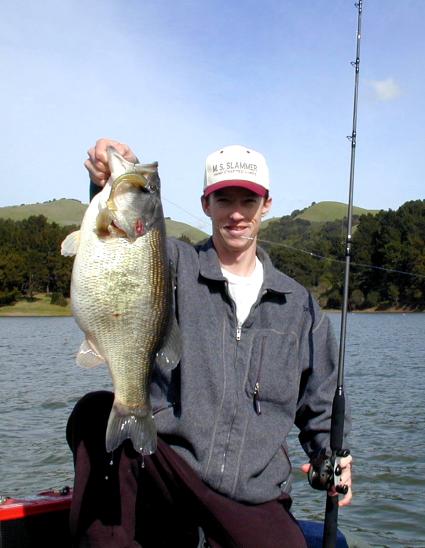|
I should start this section by providing a backgrounder on the lake where I've been developing these swimbait techniques. It's Santa Margarita Lake, a small lake on the Central Coast of California. The fish are northern strain largemouth (no smallmouth or spots) and the forage consists primarily of threadfin shad, crawdads, frogs, rainbow trout, bluegill, and golden shiners. It's the shiners that I believe the swimbait is representing. The ones I've seen have been from 3 to 8 inches in length and look a lot like a sardine. The lake experiences heavy weed growth in the summer time consisting of leafy brown weeds on the bank and grass on the outside. There are some tullies but they don't dominate the shoreline and while there is some timber at high water, once the lake gets down a little ways there is very little save for the old river channel.
There are four basic scenarios where I've found the swimbait to be effective:
1. During mid-summer the grass beds began forming up solidly and had a distinct outer edge. In the middle of the day the fish would hunker down there in 12-18 feet of water. It was tough to reach them with crankbaits because of the amount of grass and worming was equally frustrating, as you would be pulling grass off your bait on every cast. The swimbait presented an excellent solution. I would line up parallel casts along the outer grass lines and swim the bait slowly over the grass. Unlike a crankbait, which would either be stuck in the grass right away or only be in the strike zone for a few feet before it started coming up, I could fish the swimbait across 50 to 100 foot stretches holding it at a nearly constant depth over the weeds. Since the hook is on top of the bait, it actually slides over the grass pretty good if you do drag it too deep. A steady wind from the moment the bait splashes down is most effective in this, and pretty much every other situation. The bites were pretty subtle during this time of year. The fish would either inhale it causing your line to go slack momentarily, hit it and turn to the side, or the most frustrating bite where you'd get a tap tap tap tap and then MAYBE a solid thunk. What you learn to do is just keep reeling on these tap tap bites. The fish will usually keep hitting it until they get it. If you set on the first tap, forget about it, it's just the fish yanking on the tail. You do want to set hard on any indication that your line has gone slack though. These are usually the better fish that have the authority to inhale a 5 inch bait, and they can spit it just as quick as they can inhale it.
2. Fishing one evening on some vertical walls I discovered another application for the swimbait. My partner was worming with little success when I tied on a 5" big hammer. I flipped the bait up to the walls and let it flutter down with the reel in free spool. A few casts later it was on! The fish suspending on the walls couldn't resist the flutter of the swimbait tail. By then end of the night (an hour and 7 fish later) my partner was about ready to throw me in the water, but he was sold on the swimbait. One important thing to keep in mind here is that you never ever want to use the rod to impart action to a swimbait. Any action you impart should be done using the reel. When my bait would hit on the wall or at it's base, I just flipped the reel in to gear and started winding. Lifting your rod tip means at some point you have to lower it, creating slack and causing you to lose touch with the bait. Bad idea because if the fish grabs it, you're likely to get an awkward hookset and farm him!
3. Another interesting application of the swimbait hit me one day as my friend Matt Peters and I were cranking some submerged stickups in the old river channel. Matt located the old willow trees with his deep diving crank in otherwise open water and we followed the channel for a quarter mile or so. The cranks kept getting hung in the rotting willow trees but the swimbait fluttered right over them and produced three nice fish for us that first day. It was similar to fishing the outside of the grass beds in that you could keep the bait at the right depth for a long period of time without getting caught up in the structure. Something to think about if you ever come across this type of structure on your home waters.
4. As the water cooled in the fall, the fish became more active and moved up onto main lake flats where the weed beds were breaking up into loose clumps of grass and weeds in 6-14 feet of water. I think the fish were feeding on bluegill in these areas and the swimbait tail really seems to mimic this well despite the fact that the bait is not nearly as deep bodied as a bluegill. From the fish's perspective (underneath) though it probably looks just about right. I used a faster retrieve here partially because the water was shallower but also because the fish were more aggressive. I also threw a slightly larger Cardiffplastics bait in rainbow trout on their 7/8oz head. The bites were pretty aggressive compared to the summer time fish and they were really doing the grab it and swim at you thing where the line would just jump or slack up. Time to swing that long rod and rip some lips!

|
